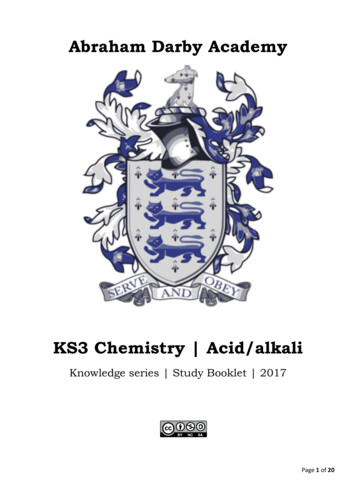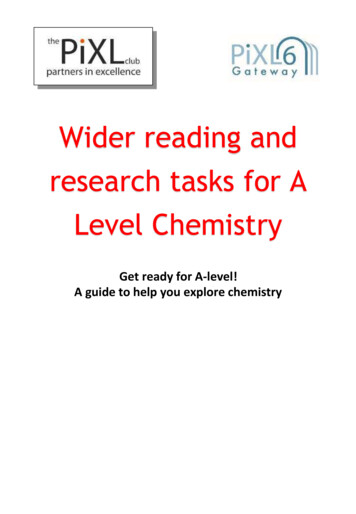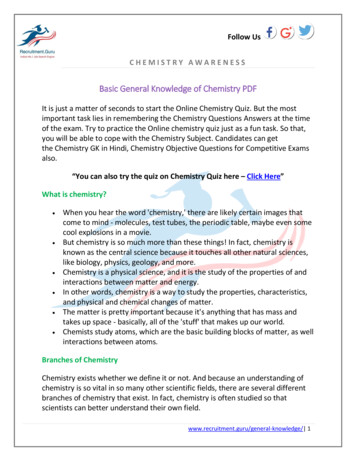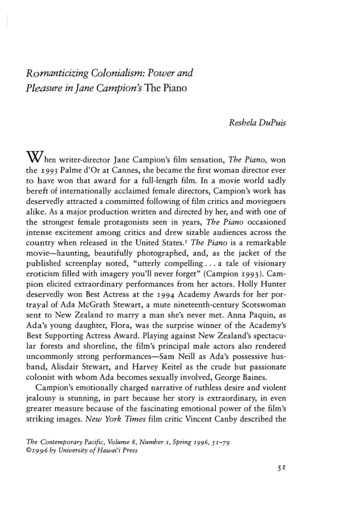
Transcription
ADA - KS3. Knowledge series Chemistry Acids and alkalis Kevin BraceAbraham Darby AcademyKS3 Chemistry Acid/alkaliKnowledge series Study Booklet 2017Page 1 of 20
ADA - KS3. Knowledge series Chemistry Acids and alkalis Kevin BraceKey terms Acid: A substance with particular chemical properties including turninglitmus red, neutralizing alkalis, and dissolving some metals. Alkali: A substance with particular chemical properties including turninglitmus blue and neutralizing or effervescing with acids. Base: A substance that will neutralise an acid, but does not dissolve inwater. pH value: A measure of acidity or alkalinity of water soluble substances(pH stands for 'potential of Hydrogen'). Atom: The smallest particle of a chemical element that can exist. Element: Each of more than one hundred substances that cannot bechemically interconverted or broken down into simpler substances andare primary constituents of matter. Compound: A thing that is composed of two or more separate elements;a mixture. Endothermic reaction: A chemical reaction that is accompanied by theabsorption of heat Exothermic reaction: A chemical reaction that is accompanied by therelease of heat Mixture; A mixture is made from different substances that are notchemically joined. Nucleus: The positively charged central core of an atom, consisting ofprotons and neutrons and containing the vast majority of mass. Electron: A subatomic particle with a charge of negative electricity,found in all atoms and acting as the primary carrier of electricity in solids. Oxidation: The gain of oxygen by a substance. For example, magnesiumis oxidised when it reacts with oxygen to form magnesium oxide:magnesium oxygen magnesium oxide. 2Mg O2 2MgO.Page 2 of 20
ADA - KS3. Knowledge series Chemistry Acids and alkalis Kevin BraceTask: Tick whether the substances listed in the table below are acid or alkali. In the far righthand column add a substance which could neutralise it.SubstanceAcidAlkaliNeutraliseVinegarOrange juiceUrineAmmoniasolutionGarden LimeIndigestionpowderCaustic sodaBlack coffeeDistilled WaterPage 3 of 20
ADA - KS3. Knowledge series Chemistry Acids and alkalis Kevin BraceTask: Fill up the pH scale below with examples of acid and alkalis (bases) – in the rightcolumn. In the left column, list common properties of these acids and alkalis (bases).PropertiesExamplesAlkali7.0AcidPage 4 of 20
ADA - KS3. Knowledge series Chemistry Acids and alkalis Kevin BraceTask: Fill in the gaps in each of the sentences below. All substances are divided into three categories:acids, alkalis and substances. There are strong and weak acids and bases, and theirstrengths are described by thescale. Acids typically taste , and will turn litmuspaper . Bases (alkalis) typically taste , and willturn litmus paper. pH value is a number from to , with as the middle(neutral) point. Values below 7 on the pH scale indicate which increases as the number, with 1 being the most . The letters pH stand for of Pure water is neutral, at pH , being neither an nor a Litmus is a water-soluble mixture of different . It is often absorbed ontofilter paper to produce one of the oldest forms of pH , used to testmaterials (i.e. soil) for acidity.Page 5 of 20
ADA - KS3. Knowledge series Chemistry Acids and alkalis Kevin BraceTask: Fill in the correct colour for the respective pH values in the table below.pH rangeDescription 3Strong acid3–6Weak acid7.0Neutral8–11Weak base 11Strong baseColourTask: Fill in the blank spaces in the statement below:The colours from yellow to red indicate an solution, colours light blueto dark blue indicate and green colour indicates that a solution is.Page 6 of 20
ADA - KS3. Knowledge series Chemistry Acids and alkalis Kevin BraceTask: Revise your knowledge of the acid and alkali key terms, by answering the ninequestions below. Underline the correct answer for each question.1. What is a chemical with a pH less than 7.0 called?acidalkali (base)neutralcompound2. What is a chemical with a pH of 7.0 called?acidalkali (base)neutralcompound3. What shows whether something is alkali or acid?elementindicatorneutralcompound4. What is a liquid with a solid dissolved in it called?solutionsolublestatinstem cell5. What is the correct terminology when substances chemically combine?a solutiona mixturea reactionan explosion6. What is a dangerous substance that dissolves other materials called?a dissolved solutiona strong alkalicorrosiveacid bathcorrosivebleacherlitmus papertinnitus7. What is a corrosive alkali is called?dangerouscaustic8. Name a red and blue indicatorblotterlampit paper9. What is the most common solvent called?A solutionneutral solutioninert gaswaterPage 7 of 20
ADA - KS3. Knowledge series Chemistry Acids and alkalis Kevin BraceNOTE: Acids and alkalis can be neutralised, by mixing (chemically) opposite compounds. Anexample of this is where farmers mix lime into soil to alter the pH balance. Anotherexample is the use of antacid tablets to help resolve stomach pain/upsets.Task: List the process and name the typical chemicals involved that can occur to give usstomach pains – in boxes 1 and 2. Explain how the antacid tablets can help defeat the painin box 3.1)2)3)Page 8 of 20
ADA - KS3. Knowledge series Chemistry Acids and alkalis Kevin BraceTask: Answer the seven questions below.1. Describe how the pH scale is related to how acidic or alkaline a solution is.2. Give the name of a compound that contains two elements joined together.3. Calculate the answer to the following question. Underline your answer.A chemist burns 0.8 g of iron in oxygen. The iron reacts to form 1.1 g of ironoxide. Calculate the mass of oxygen that reacted with the iron.1.9g1.7 g1.8 g0.3 g4. Copper is used to make electrical wires. Give two properties of copper thatallow it to be used effectively for electrical wires.Property 1Property 25. Why don’t we use wood to make electronic equipment?6. Imagine a substance that is a red, shiny solid at room temperature, with amelting point of 115 C. It is brittle and a poor conductor of heat. Statewhether this substance is a metal or a non-metal. Give a reason for youranswer.7. This model represents ethane.Write the formula for ethane.Page 9 of 20
ADA - KS3. Knowledge series Chemistry Acids and alkalis Kevin BraceTask: Locate the following words on the word search grid below.Page 10 of 20
ADA - KS3. Knowledge series Chemistry Acids and alkalis Kevin BraceTask: Read the following scenario then answer all three questions.Scene: James completes an experiment testing the pH of different acids in the lab’.Q1. Underline his control variables (what he should keep the same) from the list below:1. Volume of acid2. Volume of alkali3. Number of drops of indicator4. Type of indicator5. pH of acidQ2. Identify the independent, dependent and control variables for the above experiment.IndependentDependentControlQ3. Explain why understanding variables are so important in experiments like this.Page 11 of 20
ADA - KS3. Knowledge series Chemistry Acids and alkalis Kevin BraceTask: Describe what the diagram below shows. State the names of the chemicalreactions taking place in the diagram12345Page 12 of 20
ADA - KS3. Knowledge series Chemistry Acids and alkalis Kevin BraceTask: Answer the three questions belowQ1. Give an example of a precaution (a safety measure) you take when using an alkali.Q2. Describe what to do to treat an alkaline wasp sting and help toneutralise the effect?Q3. Study the graph below. State what the lab’ assistant changed in this experiment? Whatwould be a suitable conclusion for the experiment? Add a suitable title for the graph.Page 13 of 20
ADA - KS3. Knowledge series Chemistry Acids and alkalis Kevin BraceTasks: 1) State when and why a farmer would add alkali to his soil? 2) What would be asuitable alkali for this purpose? 3) Explain how a farmer would test the pH of his soil.Page 14 of 20
ADA - KS3. Knowledge series Chemistry Acids and alkalis Kevin BraceTask: Answer the following five questions.Q1. Write a word equation for neutralisation using these substances.Water, Sodium hydroxide, Sodium Chloride, Hydrochloric acidQ2. Underline a reactant in this word equation:Nitric acid Potassium Hydroxide Potassium Nitrate WaterQ3. Fill in in the blanks of the following sentence.Salts are made by the of acids with .Q4. Underline the correct measurement for volume.cm3 , cm2,cmQ5. If this glass beaker was 10cm diameter, and 50 cm tall; how much liquid can it contain?clue:Page 15 of 20
ADA - KS3. Knowledge series Chemistry Acids and alkalis Kevin BraceTask: You will design an experiment to compare three different acids. You need to find outwhich is the most hazardous, by observing and recording how well they react. Include all safetywear, safety precautions, and apparatus needed.Apparatus listReactants/chemicals listMethodPage 16 of 20
ADA - KS3. Knowledge series Chemistry Acids and alkalis Kevin BraceTask: What is the common link with the above food/drink items?Task: fill in the blanks to each statement below: Acids have a taste Vinegar contains acid Lemons contain acid Fizzy drinks contain acid Tea contains acid Vitamin C is also called acid, found in fruit andvegetables.Page 17 of 20
ADA - KS3. Knowledge series Chemistry Acids and alkalis Kevin BraceTask: Use the clues at the bottom of the page to complete this crossword.Across1. Burning something in air. (10)4. Chemical reaction with oxygen. (9)6. Produce palatable food by applying heat. (4)8. Atom with an excess or – electric charge.(3)9. A tiny particle, much lighter than an atom,thatcarries a negative electric charge. (8)15. Fossil fuel raw material used to make mostplastics.(3)16. A fraction of crude oil that is used in busesandlorries as a fuel. (6)17. A positive ion that travels towards thenegativecathode. (6)18. Where new chemical products form fromchemical reactants. (8)DOWN1. To react metal with the atmosphere and water.(7)2. A chemical building block used to form plastics.(7)3. A technique used to separate liquids withdifferent boiling points. (12)5. A negative ion that travels towards the positiveanode. (5)7. Fuel used in aircraft, also called kerosene.(8)10. A substance that increases the rate of achemical reaction but that is not used up itself. (8)11. Breaking long chain hydrocarbon moleculesinto more useful short chain molecules. (8)12. General name for a polymer like polythene,polypropylene, nylon and polystyrene. (7)13. A portion of crude oil with a particular boilingpoint. (8)14. A very long molecule formed from a string ofidentical chemical building blocks. Often a type ofplastic. (7)Page 18 of 20
ADA - KS3. Knowledge series Chemistry Acids and alkalis Kevin BraceTask: Revise your knowledge of the acid and alkali key terms, by answering the sixteenquestions below. Write the correct answer for each question.1. What is the chemical formula for sodium hydroxide?2. A substance with a pH of 3 would be?3. Give one example of a substance that is acidic.4. Universal indicator turns in presence of an acid5. Give two examples of substances that are alkali.6. What is the name of the compound with the formula CuO?7. The formula of sulfuric acid is?8. HNO3 is the formula for which acid?9. Complete the word equation: Acid metal carbonate 10.What is formed in a neutralisation reaction?11.CaCO3 is the formula for what?12.What is the name of the salt that is made from sulphuric acid?13.Acids have a pH of?14. Acid rain is caused by which pollutant gases?15. What can farmers put onto the soil to change the pH levels?16.What does the pH scale indicate?Page 19 of 20
ADA - KS3. Knowledge series Chemistry Acids and alkalis Kevin BraceNOTESImage attributionMost images are sourced from Wikimedia. These are shared under the Creative Commons Attribution-Share Alike 4.0International license. Other images are sourced from online repositories, i.e. Pixabay. Those are released and shared underCC0 Public Domain (i.e. freely reusable, and no attribution required).Booklet released and shared under Attribution-NonCommercial-ShareAlike 2.0Generic (CC BY-NC-SA 2.0/Page 20 of 20
ADA - KS3. Knowledge series Chemistry Acids and alkalis Kevin Brace Page 9 of 20 Task: Answer the seven questions below. 1. Describe how the pH scale is related to how acidic or alkaline a solution is. 2. Give the name of a compound that contains two elements joined together. 3. Calculate the answer to the following question. Underline .










